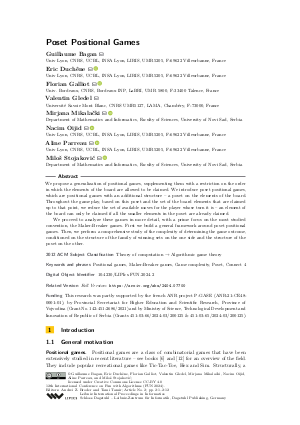Poset Positional Games
Authors
Guillaume Bagan,
Eric Duchêne  ,
Florian Galliot
,
Florian Galliot  ,
Valentin Gledel,
Mirjana Mikalački
,
Valentin Gledel,
Mirjana Mikalački  ,
Nacim Oijid
,
Nacim Oijid  ,
Aline Parreau
,
Aline Parreau  ,
Miloš Stojaković
,
Miloš Stojaković 
-
Part of:
Volume:
12th International Conference on Fun with Algorithms (FUN 2024)
Part of: Series: Leibniz International Proceedings in Informatics (LIPIcs)
Part of: Conference: International Conference on Fun with Algorithms (FUN) - License:
 Creative Commons Attribution 4.0 International license
Creative Commons Attribution 4.0 International license
- Publication Date: 2024-05-29
File

PDF
LIPIcs.FUN.2024.2.pdf
- Filesize: 0.7 MB
- 12 pages
Document Identifiers
Related Versions
- Full Version https://arxiv.org/abs/2404.07700
Subject Classification
ACM Subject Classification
- Theory of computation → Algorithmic game theory
Keywords
- Positional games
- Maker-Breaker games
- Game complexity
- Poset
- Connect 4
Metrics
- Access Statistics
-
Total Accesses (updated on a weekly basis)
0PDF Downloads0Metadata Views
Abstract
We propose a generalization of positional games, supplementing them with a restriction on the order in which the elements of the board are allowed to be claimed. We introduce poset positional games, which are positional games with an additional structure - a poset on the elements of the board. Throughout the game play, based on this poset and the set of the board elements that are claimed up to that point, we reduce the set of available moves for the player whose turn it is - an element of the board can only be claimed if all the smaller elements in the poset are already claimed. We proceed to analyze these games in more detail, with a prime focus on the most studied convention, the Maker-Breaker games. First we build a general framework around poset positional games. Then, we perform a comprehensive study of the complexity of determining the game outcome, conditioned on the structure of the family of winning sets on the one side and the structure of the poset on the other.
Cite As Get BibTex
Guillaume Bagan, Eric Duchêne, Florian Galliot, Valentin Gledel, Mirjana Mikalački, Nacim Oijid, Aline Parreau, and Miloš Stojaković. Poset Positional Games. In 12th International Conference on Fun with Algorithms (FUN 2024). Leibniz International Proceedings in Informatics (LIPIcs), Volume 291, pp. 2:1-2:12, Schloss Dagstuhl – Leibniz-Zentrum für Informatik (2024)
https://doi.org/10.4230/LIPIcs.FUN.2024.2
BibTex
@InProceedings{bagan_et_al:LIPIcs.FUN.2024.2,
author = {Bagan, Guillaume and Duch\^{e}ne, Eric and Galliot, Florian and Gledel, Valentin and Mikala\v{c}ki, Mirjana and Oijid, Nacim and Parreau, Aline and Stojakovi\'{c}, Milo\v{s}},
title = {{Poset Positional Games}},
booktitle = {12th International Conference on Fun with Algorithms (FUN 2024)},
pages = {2:1--2:12},
series = {Leibniz International Proceedings in Informatics (LIPIcs)},
ISBN = {978-3-95977-314-0},
ISSN = {1868-8969},
year = {2024},
volume = {291},
editor = {Broder, Andrei Z. and Tamir, Tami},
publisher = {Schloss Dagstuhl -- Leibniz-Zentrum f{\"u}r Informatik},
address = {Dagstuhl, Germany},
URL = {https://drops.dagstuhl.de/entities/document/10.4230/LIPIcs.FUN.2024.2},
URN = {urn:nbn:de:0030-drops-199100},
doi = {10.4230/LIPIcs.FUN.2024.2},
annote = {Keywords: Positional games, Maker-Breaker games, Game complexity, Poset, Connect 4}
}
Author Details
- Department of Mathematics and Informatics, Faculty of Sciences, University of Novi Sad, Serbia
Funding
This research was partly supported by the french ANR project P-GASE (ANR-21-CE48-0001-01), by Provincial Secretariat for Higher Education and Scientific Research, Province of Vojvodina (Grant No. 142-451-2686/2021) and by Ministry of Science, Technological Development and Innovation of Republic of Serbia (Grants 451-03-66/2024-03/200125 & 451-03-65/2024-03/200125).
References
- James D. Allen. Expert play in Connect-Four, 1990. URL: https://tromp.github.io/c4.html.
-
James D. Allen. The Complete Book of Connect 4: History, Strategy, Puzzles. Puzzlewright Press, 2010.

-
Louis Victor Allis. A Knowledge-Based Approach of Connect-Four. Report IR-163. Vrije Universiteit Amsterdam, The Netherlands, 1988.

- Pranav Avadhanam and Siddhartha G. Jena. Restricted positional games. CoRR, 2021. Preprint. URL: https://arxiv.org/abs/2108.12839.
- Guillaume Bagan, Éric Duchêne, Florian Galliot, Valentin Gledel, Mirjana Mikalački, Nacim Oijid, Aline Parreau, and Miloš Stojaković. Poset positional games. CoRR, 2024. Preprint. URL: https://arxiv.org/abs/2404.07700.
- József Beck. Combinatorial Games: Tic-Tac-Toe Theory. Encyclopedia of Mathematics and its Applications. Cambridge University Press, 2008. URL: https://doi.org/10.1017/CBO9780511735202.
-
Jesper Makholm Byskov. Maker-Maker and Maker-Breaker games are PSPACE-complete. BRICS Report Series, 11(14), 2004.

- Noam D. Elkies. On numbers and endgames: combinatorial game theory in chess endgames. In Games of No Chance, Proceedings of 7/94 MSRI Conference on Combinatorial Games, pages 135-150. Cambridge University Press, 1996. URL: https://api.semanticscholar.org/CorpusID:17418896.
- Paul Erdős and John L. Selfridge. On a combinatorial game. Journal of Combinatorial Theory, 14:298-301, 1973. URL: https://doi.org/10.1016/0097-3165(73)90005-8.
- Florian Galliot, Sylvain Gravier, and Isabelle Sivignon. Maker-Breaker is solved in polynomial time on hypergraphs of rank 3. CoRR, 2022. Preprint. URL: https://arxiv.org/abs/2209.12819.
-
Alfred W. Hales and Robert I. Jewett. Regularity and positional games. Trans. Am. Math. Soc, 106:222-229, 1963.

- Dan Hefetz, Michael Krivelevich, Miloš Stojaković, and Tibor Szabó. Positional Games, volume 44 of Oberwolfach Seminars. Birkhäuser (Springer), 2014. URL: https://doi.org/10.1007/978-3-0348-0825-5.
-
Md Lutfar Rahman and Thomas Watson. 6-uniform Maker-Breaker game is PSPACE-complete. In Proceedings of the 38th International Symposium on Theoretical Aspects of Computer Science (STACS 2021), volume 187 of Leibniz International Proceedings in Informatics (LIPIcs), pages 57:1-15, 2021.

-
Thomas J. Schaefer. On the complexity of some two-person perfect-information games. Journal of Computer and System Sciences, 16:185-225, 1978.

-
Larry J Stockmeyer and Albert R Meyer. Word problems requiring exponential time (preliminary report). In Proceedings of the Fifth Annual ACM Symposium on Theory of Computing, pages 1-9, 1973.

- John Tromp. John’s Connect Four Playground. URL: http://tromp.github.io/c4/c4.html.
-
John Tromp. Solving Connect-4 on medium board sizes. ICGA Journal, 31(2):110-112, 2008.

